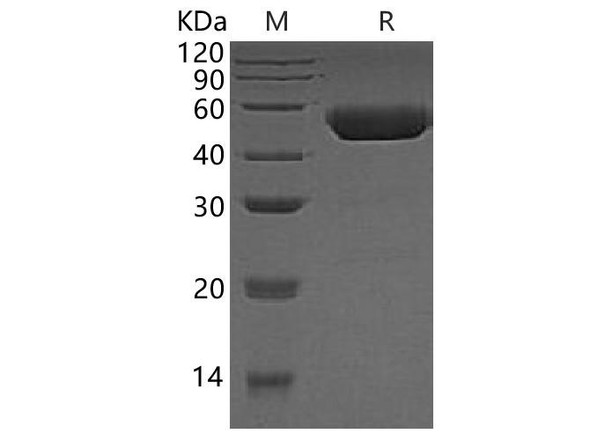Enzymes Recombinant Proteins
Mouse CTSD Recombinant Protein (RPPB1516)
- SKU:
- RPPB1516
- Product Type:
- Recombinant Protein
- Species:
- Mouse
- Uniprot:
- P18242
- Research Area:
- Enzymes
Description
| Product Name: | Mouse CTSD Recombinant Protein |
| Product Code: | RPPB1516 |
| Size: | 5µg |
| Species: | Mouse |
| Target: | CTSD |
| Synonyms: | Ctsd, CatD, CD, Cathepsin D. |
| Source: | Sf9 Insect cells |
| Physical Appearance: | Sterile Filtered colorless solution. |
| Formulation: | CTSD protein solution (0.25mg/ml) contains PhosphateBuffered Saline (pH 7.4) and 10% glycerol. |
| Stability: | Store at 4°C if entire vial will be used within 2-4 weeks. Store, frozen at -20°C for longer periods of time. For long term storage it is recommended to add a carrier protein (0.1% HSA or BSA).Avoid multiple freeze-thaw cycles. |
| Purity: | Greaterthan 90.0% as determined by SDS-PAGE. |
| Amino Acid Sequence: | IIRIPLRKFT SIRRTMTEVG GSVEDLILKG PITKYSMQSS PKTTEPVSELLKNYLDAQYY GDIGIGTPPQ CFTVVFDTGS SNLWVPSIHC KILDIACWVH HKYNSDKSST YVKNGTSFDIHYGSGSLSGY LSQDTVSVPC KSDQSKARGI KVEKQIFGEA TKQPGIVFVA AKFDGILGMG YPHISVNNVLPVFDNLMQQK LVDKNIFSFY LNRDPEGQPG GELMLGGTDS KYYHGELSYL NVTRKAYWQV HMDQLEVGNELTLCKGGCEA IVDTGTSLLV GPVEEVKELQ KAIGAVPLIQ GEYMIPCEKV SSLPTVYLKL GGKNYELHPDKYILKVSQGG KTICLSGFMG MDIPPPSGPL WILGDVFIGS YYTVFDRDNN RVGFANAVVL LEHHHHHH |
| Biological Activity: | Specific activity is > 1,000 pmol/min/ug in which oneunit will convert 1.0 pmole of Mca-PLGL-Dpa-AR-NH2 to MCA- Pro-Leu-OH perminute at pH 3.5 at 25C. |
Cathepsin D is synthesized as a 54kDa precursor, which is proteolytically processed to an intermediate 48kDa single chain, which matures into more stable 34kDa and 14kDa two chain form. It is an estrogen-regulated lysosomal protease that has been suggested to facilitate cancer cell migration and invasion by digesting the basement membrane, extracellular matrix, and xonnective tissue. Because of its mitogenic and proteolytic activities, it has been implicated as a prognostic marker in many tumor types. Cathepsin D is expressed in epithelial cells as well as in macrophages.
CTSD produced in Sf9 Baculovirus cells is a single,glycosylated polypeptide chain containing 398 amino acids (21-410 a.a.) andhaving a molecular mass of 44.0kDa (Molecular size on SDS-PAGE will appear atapproximately 40-57kDa). CTSD is expressed with an 8 amino acid His tag atC-Terminus and purified by proprietary chromatographic techniques.
| UniProt Protein Function: | CTSD: Acid protease active in intracellular protein breakdown. Involved in the pathogenesis of several diseases such as breast cancer and possibly Alzheimer disease. Consists of a light chain and a heavy chain. Belongs to the peptidase A1 family. |
| UniProt Protein Details: | Protein type:Autophagy; Motility/polarity/chemotaxis; Protease; EC 3.4.23.5 Cellular Component: extracellular matrix; extracellular space; mitochondrion; lysosome; extracellular region Molecular Function:peptidase activity; hydrolase activity; endopeptidase activity; aspartic-type endopeptidase activity; peptide binding Biological Process: proteolysis; autophagic vacuole formation |
| UniProt Code: | P18242 |
| NCBI GenInfo Identifier: | 115718 |
| NCBI Gene ID: | 13033 |
| NCBI Accession: | P18242.1 |
| UniProt Related Accession: | P18242 |
| Molecular Weight: | 44,954 Da |
| NCBI Full Name: | Cathepsin D |
| NCBI Synonym Full Names: | cathepsin D |
| NCBI Official Symbol: | Ctsd�� |
| NCBI Official Synonym Symbols: | CD; CatD�� |
| NCBI Protein Information: | cathepsin D |
| UniProt Protein Name: | Cathepsin D |
| Protein Family: | Cathepsin |
| UniProt Gene Name: | Ctsd�� |
| UniProt Entry Name: | CATD_MOUSE |






